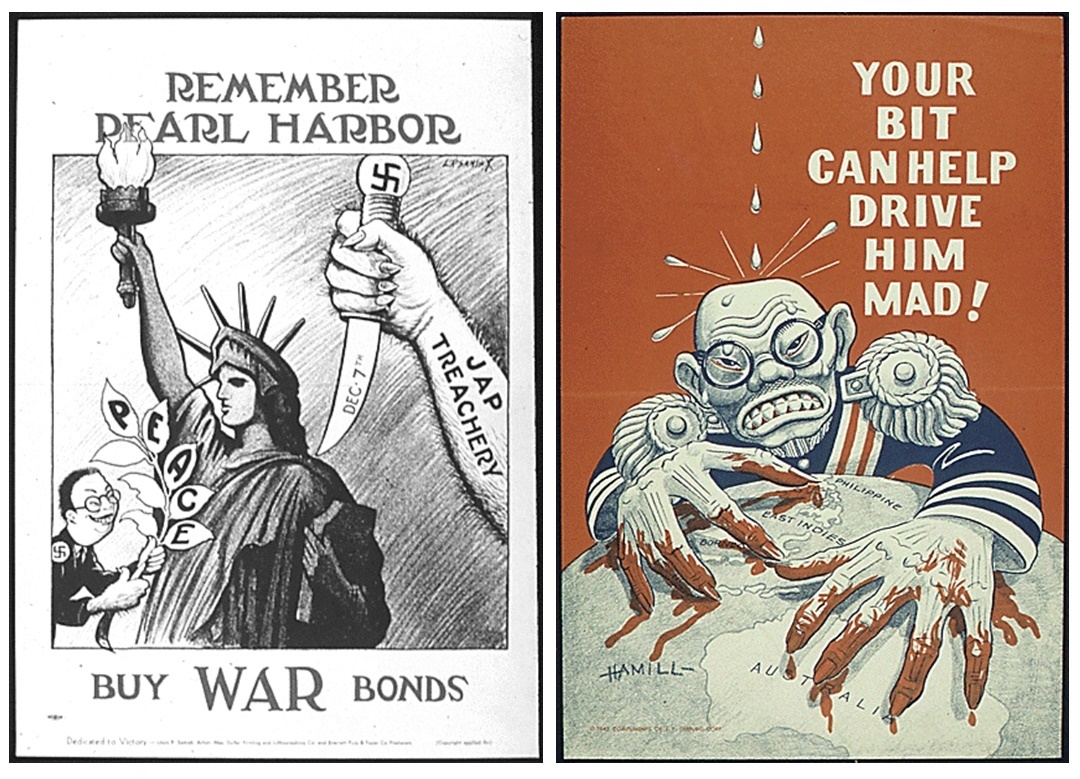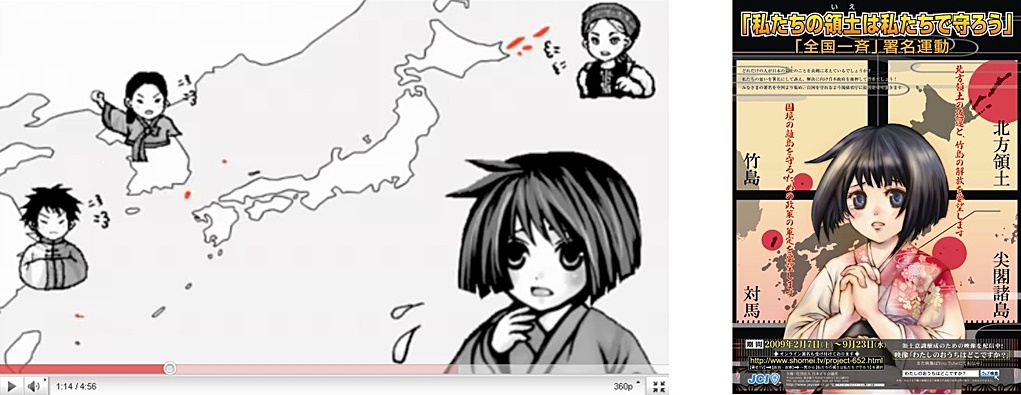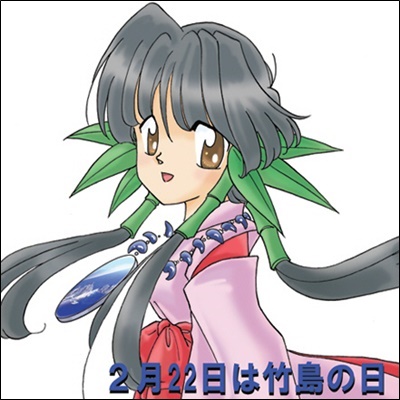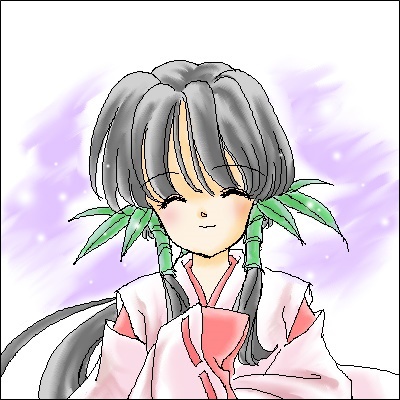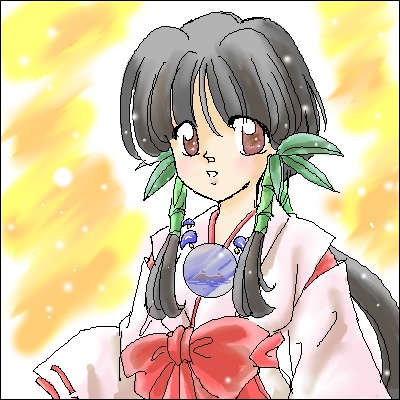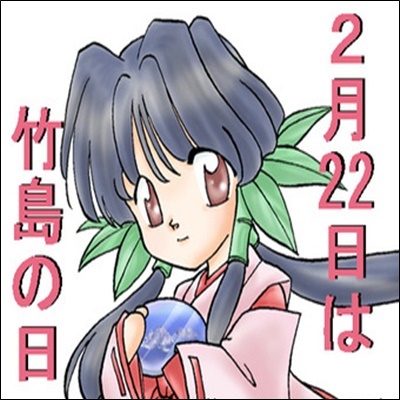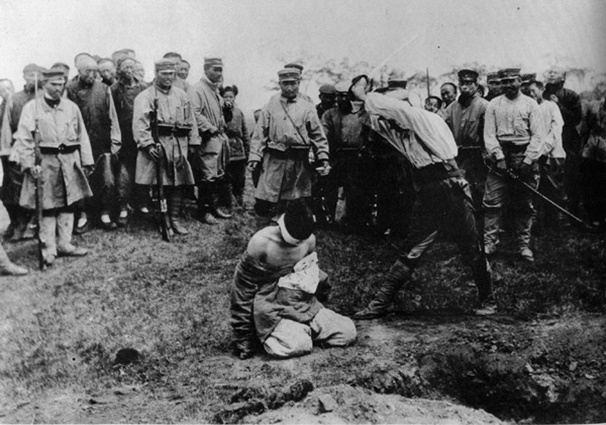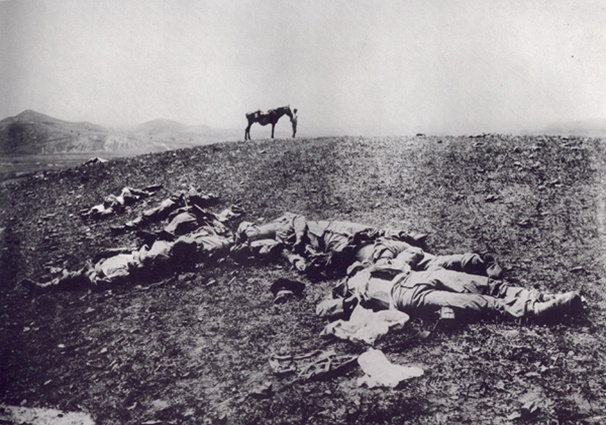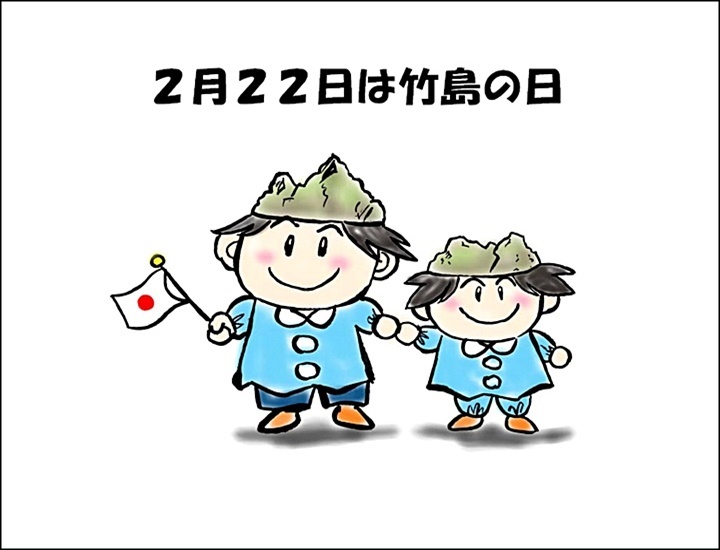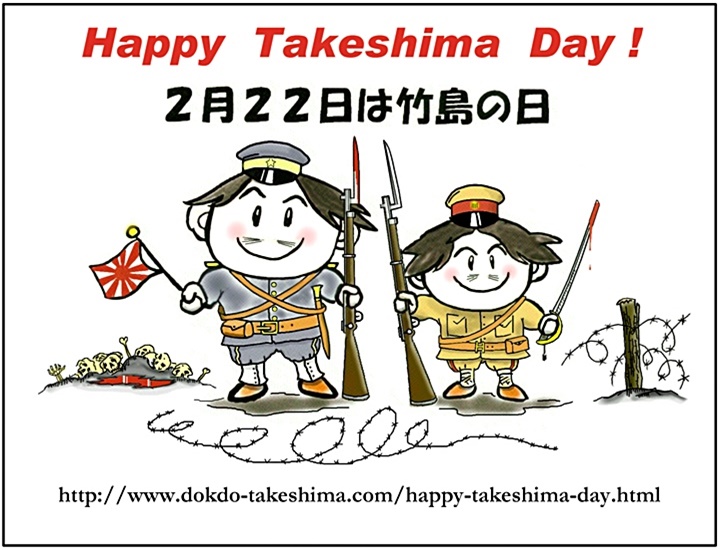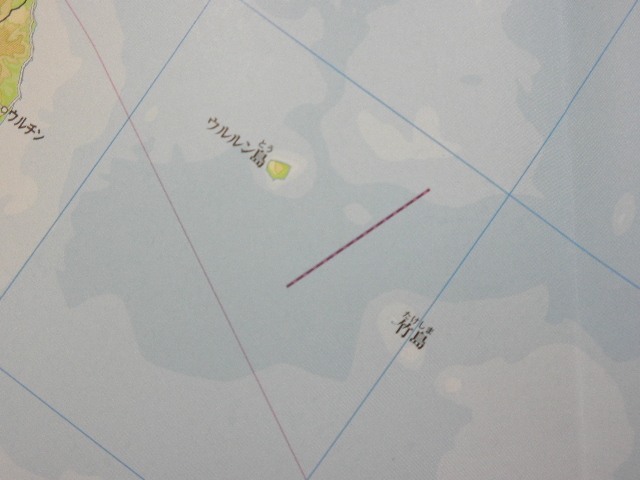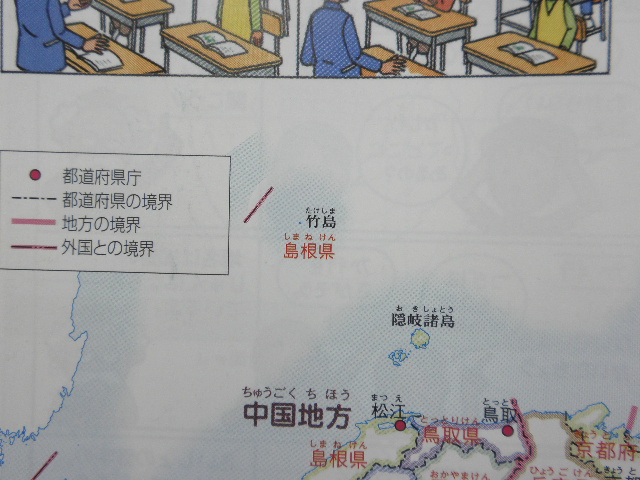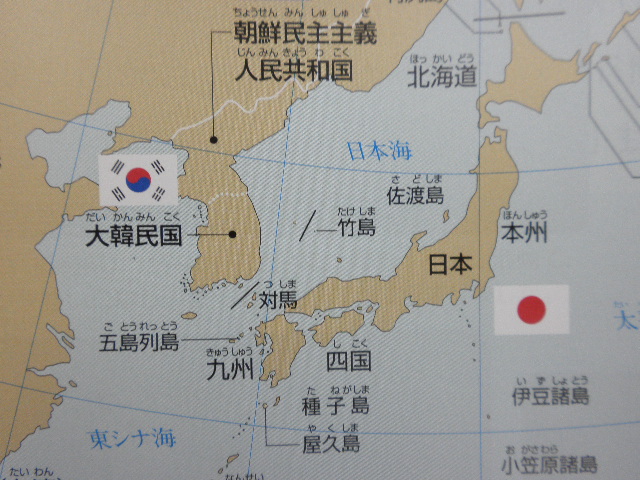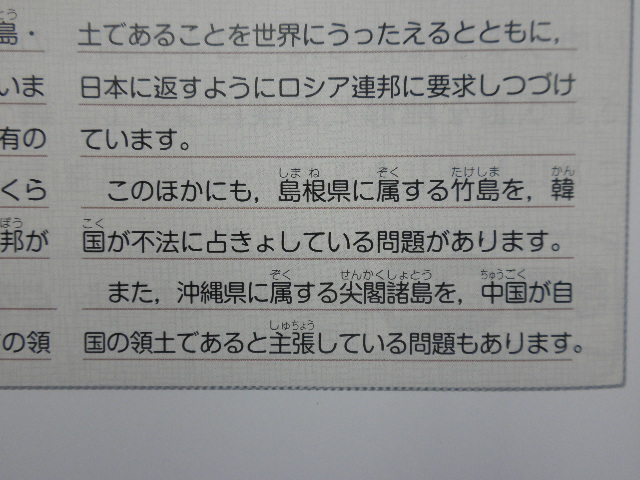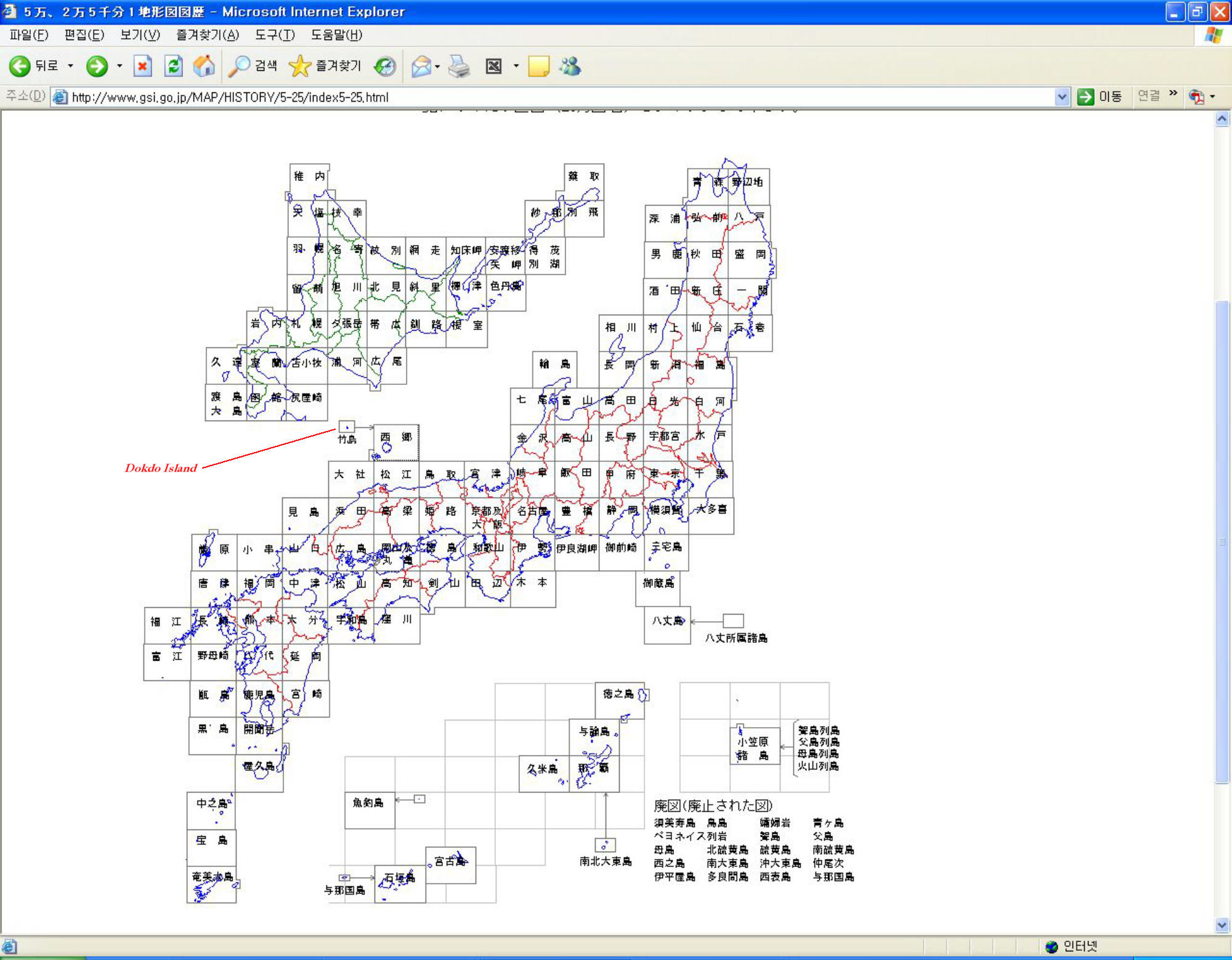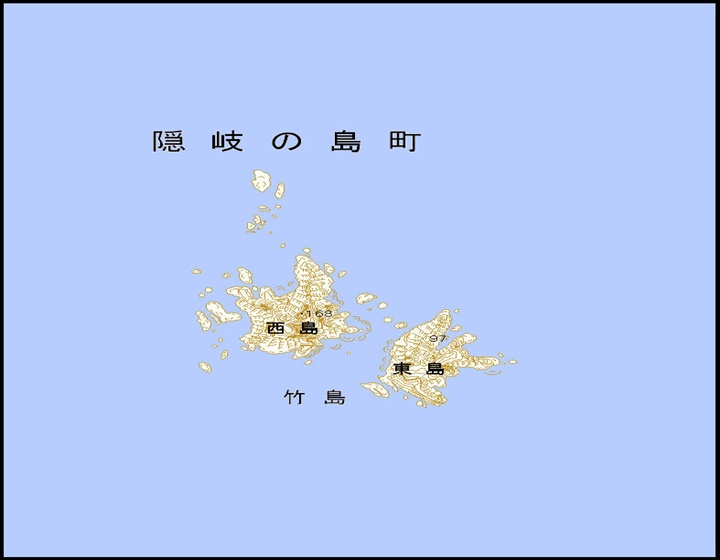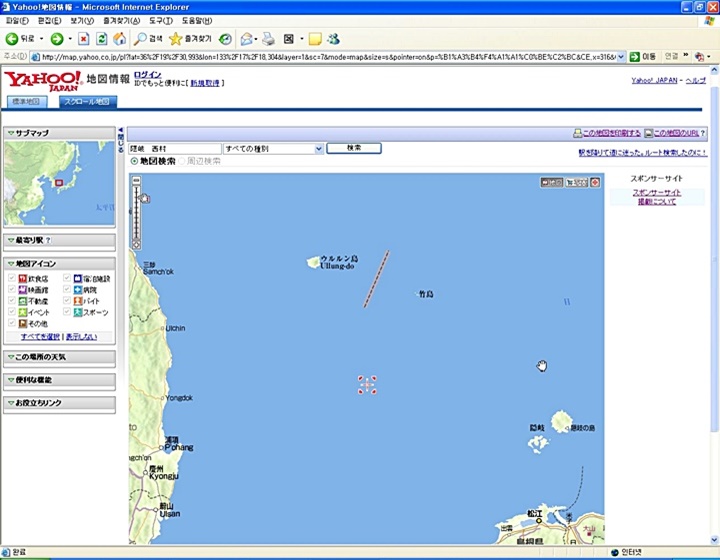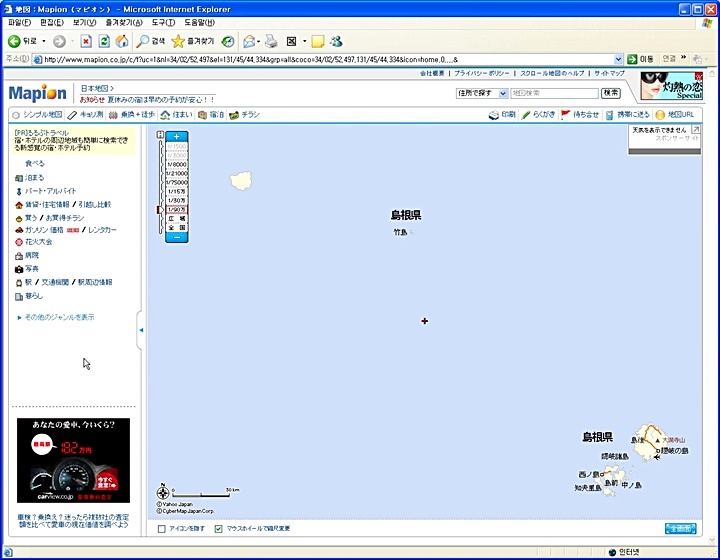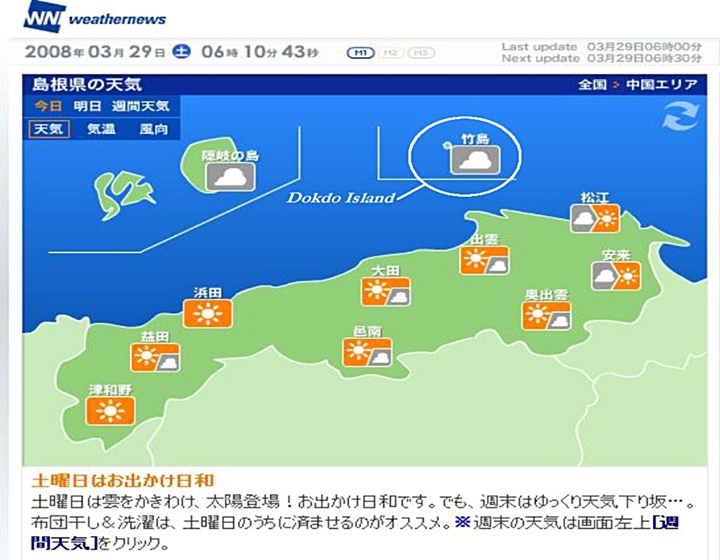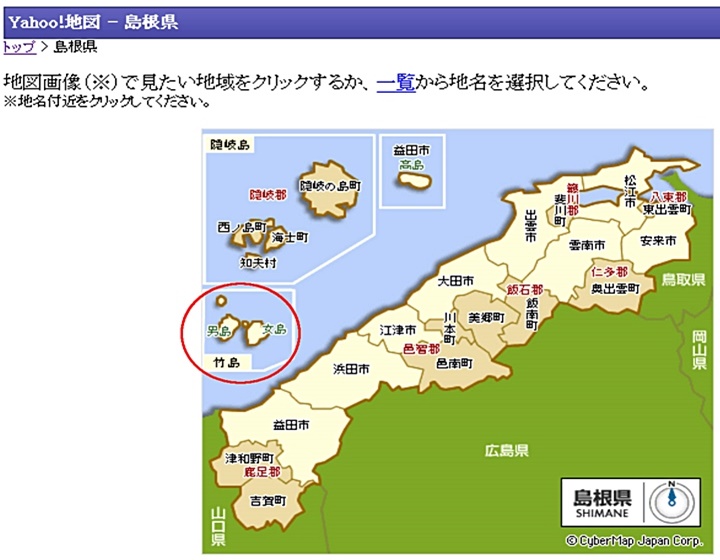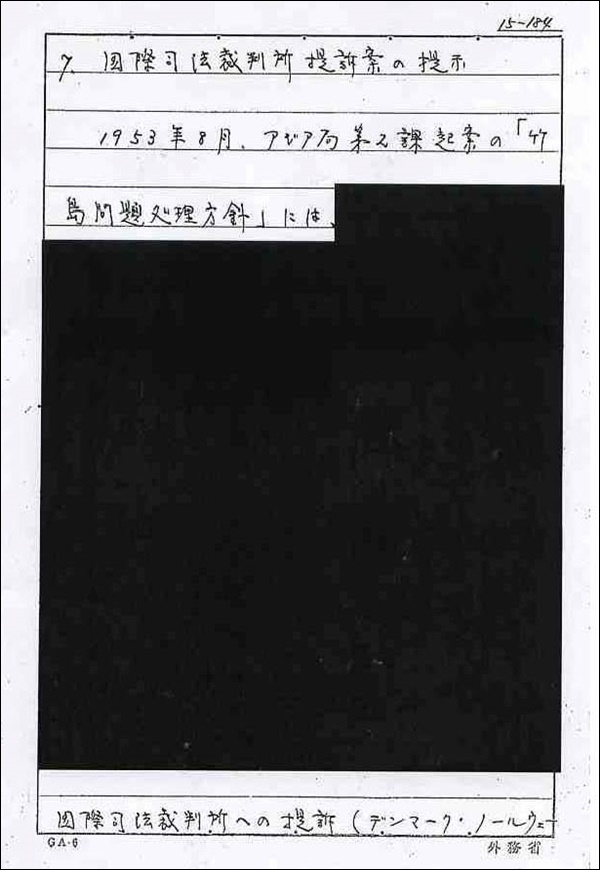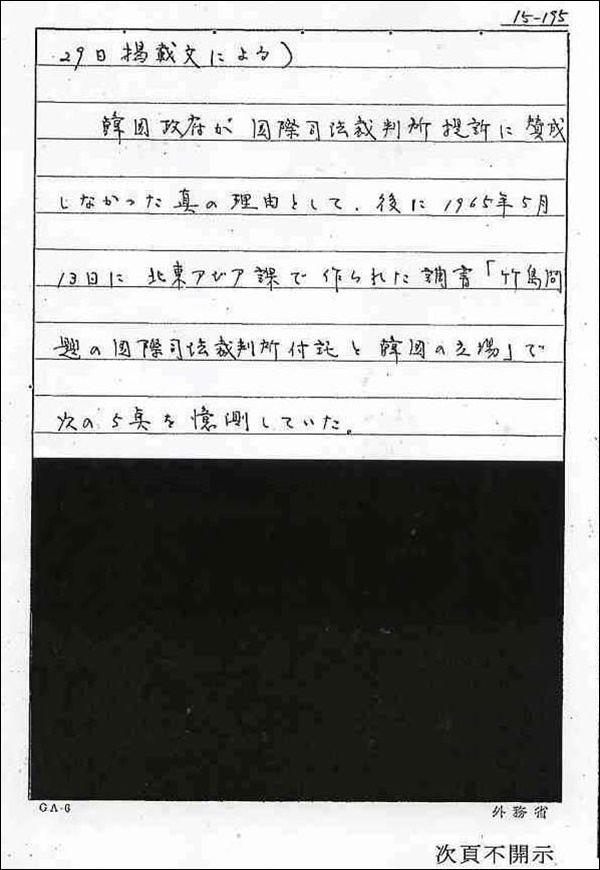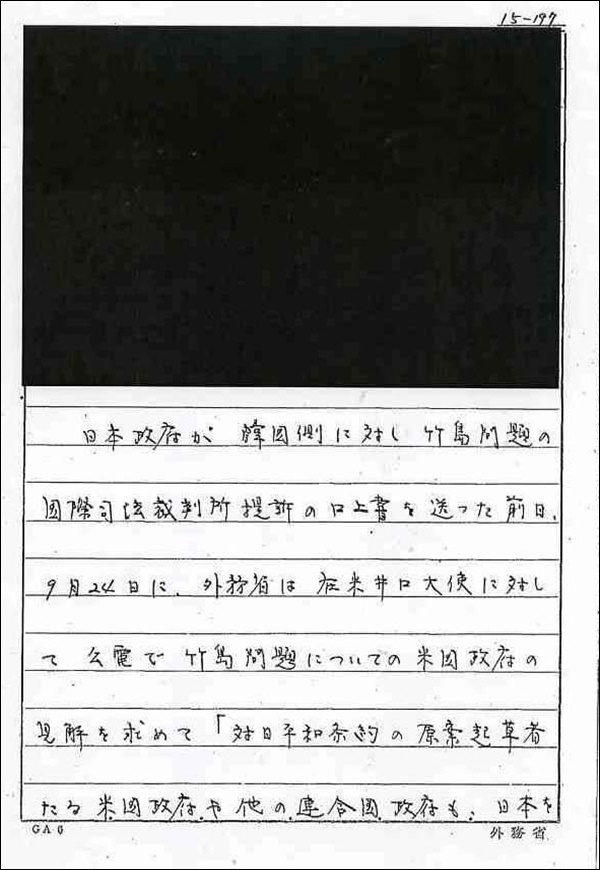What message is the Japanese government sending with her approach toward the Dokdo Island problem? Why does Korea still perceive Japan as a hostile country, even decades after the 1965 Treaty on Basic Relations?
For decades after WWII, westerners viewed Japan with distrust. This may have been attributed to Japan’s sneak attack on Pearl Harbor and subsequent wartime atrocities. During World War II, Western media depicted Japanese as cunning backstabbers or insatiable land grabbers. Japan’s past policy of stating something but doing the opposite made it very difficult for the nation to regain global trust.
This advertisement below left uses a cute (blue eyed?) anime girl dressed in traditional Japanese clothes. Her eyes well with tears as she worries over Japan’s future. Oddly enough three of the highlighted territories, Dokdo (竹島), the Kurils and Diaoya (Senkaku) were not inherent parts of ancient Japan.
While Japan’s right wing lunatic fringe candy-coats Takeshima Day, Koreans watch in disbelief. We must ask ourselves, do Japanese citizens really know the true history of her involvlement on Dokdo Island? Do they realize Japan’s whole case for Dokdo Takeshima is based on her military annexation of the islands while Japan colonized Korea? Perhaps, if Japanese were taught the historical reality of Takeshima Day, they might understand why Koreans are so distrustful.
From there JCI claims the Takeshima is a part of “Japan’s house” to infuriate Japanese citizens. The ugly characatures of Chinese, Russians and Koreans is an obvious attempt to demonize other Asians. At the same time, Japanese citizens are represented by a cute, innocent animae girl or passive pussy-cats. Most appalling are the accusations that Chinese, Koreans, Russians and Taiwanese are thieves and trespassers. Japanese citizens are then instructed to defend “their home” without any real background as to why these territories are really “Japanese”.
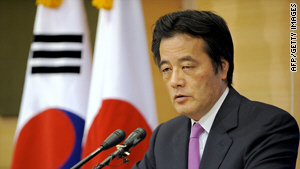 In Februrary of 2010 ahead of the 100th anniversary of Japan’s colonial rule over Korea, Japanese Foreign Minister Katsuya Okada apologized to South Korea for the more than three decades when Japan ruled over Korea, calling the time a “tragic incident.”
In Februrary of 2010 ahead of the 100th anniversary of Japan’s colonial rule over Korea, Japanese Foreign Minister Katsuya Okada apologized to South Korea for the more than three decades when Japan ruled over Korea, calling the time a “tragic incident.”
Katsuya Okada added “I can fully understand the feelings of (Koreans) who were deprived of their identity and nation. I believe we must never forget the victims,” For a brief while it seemed perhaps Korea and Japan may improve ties with each other, but it was not to be. Only weeks later, the Japanese Ministry of Education announced it had approved schoolbooks clarifying Dokdo (Takeshima) as Japanese territory.
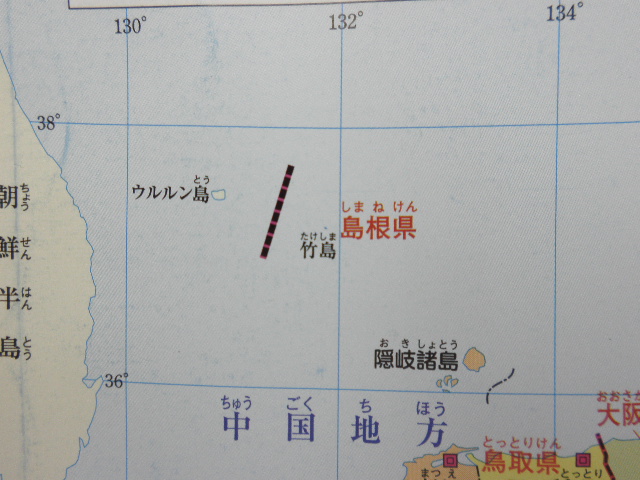 Immediately, South Korea took a more aggressive stance against Japan’s claim over Dokdo as President Lee Myung-bak expressed an intention to bolster Seoul’s “effective control” of the islets and the legislature adopted a resolution to denounce Tokyo’s latest move.
Immediately, South Korea took a more aggressive stance against Japan’s claim over Dokdo as President Lee Myung-bak expressed an intention to bolster Seoul’s “effective control” of the islets and the legislature adopted a resolution to denounce Tokyo’s latest move.
Left: This image is from a recent Japanese schoolbook. It shows how Japan’s Education Ministry unilaterally declared a false Japan – Korea boundary and wrongly marked Dokdo (Takeshima) as part of Shimane Prefecture. (島根県) in red.
As long as the Japanese government continues to say one thing but do another, Korea and Japan will never build a lasting friendship. Relationships, personal or political are based on simple principles such as honesty, sincerity and trust. Japan cannot support the selfish territorial ambitions of Shimane Prefecture and right wing expansionists while feigning regret for the colonization of Korea.
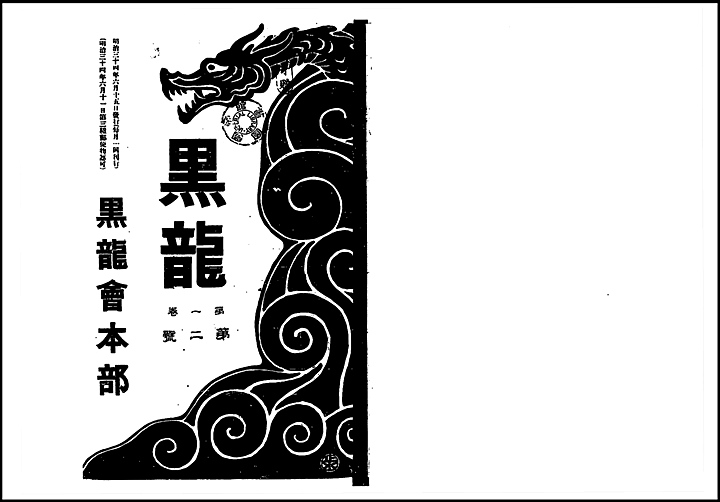 The Dark/Black Ocean Society (玄洋社, Gen’yōsha?) was an influential ultranationalist group and secret society active in Meiji, Taishō and early Shōwa period Japan Gen’yōsha (玄洋社 “Occult Ocean Society”) – originated from a secret society of ex-samurai with an aim to restore feudal rule, Genyosha was an ultranationalist secret society which engaged in terrorist activities, such as the attempted assassination of Okuma Shigenobu in 1889. It formed an extensive espionage and organized crime network throughout east Asia and agitated for Japan’s military aggression. These organizations were utilized during Japan’s expansionist era to increase the Japanese empire in all directions.
The Dark/Black Ocean Society (玄洋社, Gen’yōsha?) was an influential ultranationalist group and secret society active in Meiji, Taishō and early Shōwa period Japan Gen’yōsha (玄洋社 “Occult Ocean Society”) – originated from a secret society of ex-samurai with an aim to restore feudal rule, Genyosha was an ultranationalist secret society which engaged in terrorist activities, such as the attempted assassination of Okuma Shigenobu in 1889. It formed an extensive espionage and organized crime network throughout east Asia and agitated for Japan’s military aggression. These organizations were utilized during Japan’s expansionist era to increase the Japanese empire in all directions.
On the left is an image of the 1901~1903 Edition of Japanese, Ultra-Right-Wing Black Dragon’s Chosun Fishing Manual, showing how Japan was encroaching into Korean waters, this record gave details into the fishing conditions in Korean East coast, Ulleungdo and Dokdo Island. ( link )
Originally ignored by the Japanese military, during the First Sino-Japanese War and Russo – Japanese War, both the Imperial Japanese Army and Imperial Japanese Navy found the Gen’yōsha’s extensive intelligence gathering network throughout East Asia to be invaluable. The Gen’yōsha network was also useful for the military in conducting sabotage activities behind enemy lines.
 One prominent political figure who was involved with Japan’s 1905 annexation of Dokdo Takeshima was Yamaza Enjiro. It was during the diary of Nakai Yozaburo a Japanese citizen who wanted to lease Dokdo that Yamaza Enjiro, the director of the Political Affairs Bureau, stated it was necessary to annex the islets for military purposes during the Russo Japanese War.
One prominent political figure who was involved with Japan’s 1905 annexation of Dokdo Takeshima was Yamaza Enjiro. It was during the diary of Nakai Yozaburo a Japanese citizen who wanted to lease Dokdo that Yamaza Enjiro, the director of the Political Affairs Bureau, stated it was necessary to annex the islets for military purposes during the Russo Japanese War.
A native of Fukuoka, Yamaza was close to the Genyosha and shared many of its ideals. In 1904 he had been an adamant advocate of war with Russia, a position that had put him at odds with the political powerbroker and former prime minister Ito Hirofumi. Yamazo Enjiro worked in tandem with the Japanese Imperial Navy to annex Dokdo Island for the installation of naval watchtowers and telegraph facilities.
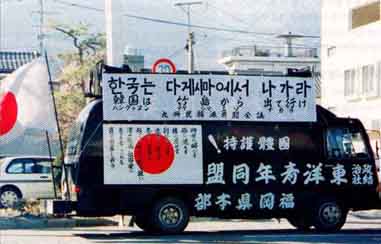 The Uyoku dantai (右翼団体; literally “right wing groups”) are Japanese nationalist right-wing groups. In 1996, the National Police Agency estimated that there are over 1000 right wing groups in Japan with about 100,000 members in total. Uyoku dantai are well known for their highly visible propaganda vehicles, known as gaisensha (街宣車)–converted vans, trucks and buses fitted with loudspeakers and prominently marked with the name of the group and propaganda slogans.
The Uyoku dantai (右翼団体; literally “right wing groups”) are Japanese nationalist right-wing groups. In 1996, the National Police Agency estimated that there are over 1000 right wing groups in Japan with about 100,000 members in total. Uyoku dantai are well known for their highly visible propaganda vehicles, known as gaisensha (街宣車)–converted vans, trucks and buses fitted with loudspeakers and prominently marked with the name of the group and propaganda slogans.
To the left a typical Japanese, Takeshima propaganda van. The crudely scrawled Korean written on the van orders Koreans to “Get out of Takeshima!!” Korean.
The vehicles are usually black, khaki or olive drab, and are decorated with the Imperial Seal, the flag of Japan and the Japanese military flag. They are primarily used to stage protests outside organizations such as the Chinese, Korean or Russian embassies, Chongryon facilities and media organizations, where propaganda (both taped and live) is broadcast through their loudspeakers.
“…The Geographical Survey Institute (GSI) is the only national organization that conducts basic survey and mapping and instructs related organizations to clarify the conditions of land in Japan and that provides the results of surveys to help improve this land….”
This map by Japan’s National Geographical Survey Institute shows Dokdo island as appended to Shimane Prefecture Oki Islands which is of course not true. Japan’s MOFA is employing other government agencies to deliberately mislead their own public as well as the international community. Please click the map twice for a very large image.
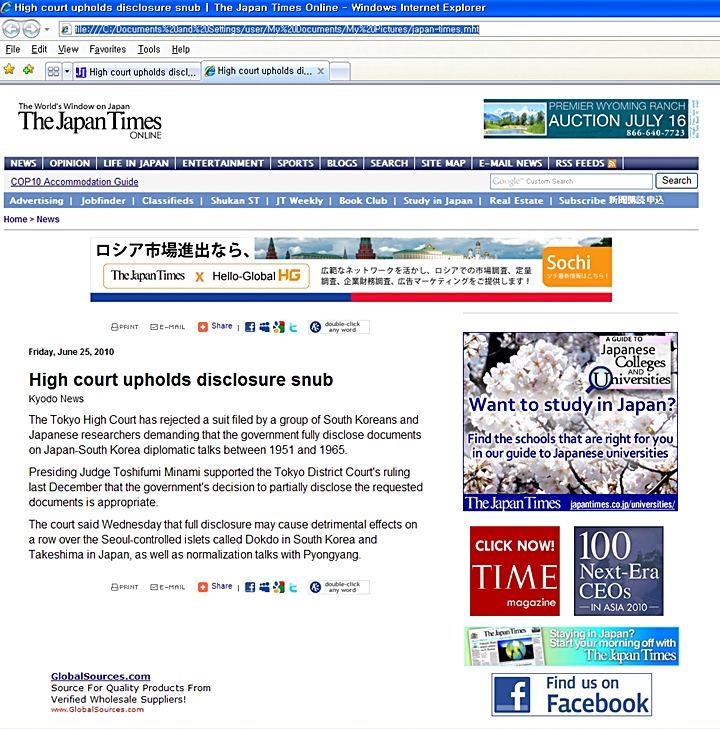 Searching for the historical truth of Dokdo Takeshima has been hampered by the Japanese government. Korean and Japanese researchers who tried to access post WWII records detailing Japan’s relationship with the islets have met strong opposition.
Searching for the historical truth of Dokdo Takeshima has been hampered by the Japanese government. Korean and Japanese researchers who tried to access post WWII records detailing Japan’s relationship with the islets have met strong opposition.
Despite these obstacles, Korean researcher, Ms Yu Mi-Rim discovered two Japanese government documents that explicitly disproved Tokyo’s persistent claims to Dokdo Takeshima. The documents in question are “Ordinance No. 24 of the Prime Minister’s Office,” dated June 6, 1951, and “Ordinance No. 4 of the Ministry of Finance,” dated February 13 of the same year.
Both decrees explicitly provided that, among islands adjacent to Japan proper, Jejudo, Ulleungdo and Dokdo Takeshima were excluded from Japanese governmental and administrative authority, thus clearly affirming that those islands are not parts of Japan’s inherent territory. The fact that the Japanese government in 1951 promulgated the two ordinances in conformity with the SCAPIN-677 confirmed undisputedly that Japan did not have territorial rights over Dokdo.
However, the Japanese government still refuses to disclose other government historical records about Dokdo Takeshima Island realizing that there is further evidence Japan did not consider the islets Japanese territory post WWII. As recently as June 25th 2010, Japan’s High Court refused to release historical records regarding Dokdo Takeshima fearing they could affect Japan’s claim to the disputed islands. Below we can see some original Japanese government documents that were deliberately blacked-out to conceal related historical data.
 So really does the Dokdo Takeshima problem have an impact on Japanese Korean ties? Well, a recent poll revealed that not only is the Dokdo Island dispute a huge barrier against Japanese Korean relations it is the number one historical issue facing Koreans today. Almost half of all Koreans surveyed said the Dokdo Takeshima dispute is the nation’s biggest historical problem.
So really does the Dokdo Takeshima problem have an impact on Japanese Korean ties? Well, a recent poll revealed that not only is the Dokdo Island dispute a huge barrier against Japanese Korean relations it is the number one historical issue facing Koreans today. Almost half of all Koreans surveyed said the Dokdo Takeshima dispute is the nation’s biggest historical problem.
Respondents ranked the issue even higher than the Comfort Women issue and the controversial Yasukuni Shrine. It’s also important how Koreans consider the Dokdo Takeshima Issue a historical problem rather than just a territorial dispute. This differs from Japanese who tend to think the Dokdo Takeshima problem is mostly a territorial problem over natural resources.
Modern Japan has reached a crossroads. With eroding influence in Asia and unresolved issues from her wartime and colonial eras still smoldering, Japan’s MOFA must alter her methods to suit the times or risk being frozen out of Northeast Asia. The Japanese government bears the responsibility of creating and implementing foreign policy that fosters peace and regional prosperity. However, Japan’s Minsitry of Foreign Affairs continues to appease her right wing and supports Shimane Prefecture’s lust for territory.
Today’s Japan should face up to the historical, economic, political realities of Northeast Asia and drop her claim to Dokdo Island. That would, no doubt, be a huge step in the right direction toward peaceful Korean – Japanese relations.

